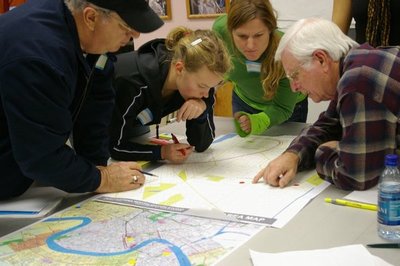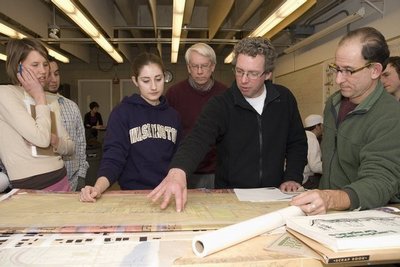March 8, 2007
Post-Katrina: Design for recovery
A UW effort to help rebuild a community along the hurricane-ravaged Gulf Coast is a drop in the bucket stacked against the $110 billion the government has budgeted for recovery.
Still, it’s a drop that 28 graduate students are pouring significant time and energy into, as they ponder strategies to revive a portion of Terrytown, an unincorporated bedroom community of 25,000 outside New Orleans.
Working under a $300,000 federal grant, students are focusing on a section of town described as “seedy” by Chris Roberts, the Jefferson Parish councilman whose district includes the area. It is marked, he said, by a high crime rate, lack of landlord investment, and high concentration of low-income residents.
While the area suffered some water and wind damage from Katrina, its greatest loss resulted from the man-made aftermath — looters who plundered a regional shopping mall and set it on fire.
Besides employing some 1,300 people, the mall was a major source of property tax revenue. With the adjacent neighborhood already in decline when Katrina and the looters hit, the mall’s Illinois-based owners were questioning if it was even worth rebuilding, Roberts recalled.
The owners have since committed to rebuilding, but Roberts noted that the mall’s future performance will depend on “how people feel when they get there,” which in turn will hinge on how comfortable people are moving through the adjacent areas.
Enter the UW’s so-called “PK (Post Katrina) Studio” class — a mix of urban planning, architecture and landscape architecture students, who are focusing on just that.
Under the federal grant, Jefferson Parish is partnering with the UW’s Northwest Center for Livable Communities to look for creative, comprehensive ways to secure the area’s future. Roberts estimates the mall’s total rebuilding tab, including private and public funds, to run some $40 million.
The class is doing more than developing plans to redesign street grids.
“We look at the economy, the environment, well-being, all as interrelated,” said Eric Noll, a 33-year-old, third-year doctoral student and teaching assistant who is helping to run the class. “Part of the project involves not just saying, ‘we need to make some improvement of the street grid here.’
“It’s saying things like, ‘Hey, look, if we actually extend this street so it’s connected to the rest of the grid, we’ll actually bring more traffic here and help to eliminate some of these isolated islands where crime can happen because there aren’t as many eyes on the street,’ ” Noll said.
They also are working, he said, to identify other funding sources, like Community Development Block Grants, to create business improvement districts to help spur the local economy. In other words, the work is more expansive than simply focusing on repairing the physical damage.
The project is being funded by one of 16 university grants HUD announced last year [see: http://www.hud.gov/news/release.cfm?content=pr06-025.cfm] totaling more than $5 million under a program called Universities Rebuilding America Partnership (URAP) to help rebuild the Gulf Coast.
The UW’s success in snagging one of the grants is attributable in large part to Fritz Wagner, professor and chair of the department of landscape architecture, who had formed relationships with many locals during his 28 years as a faculty member and dean at the University of New Orleans.
An exciting dimension, Wagner said, is that the project represents the first time the college’s three departments — architecture, landscape architecture and urban planning — have collaborated on the same studio project. Professor Hilda Blanco, urban planning chair, co-wrote the grant proposal.
Work on the 2-year project started during fall quarter and centers on a roughly square mile section of Terrytown on the west bank of the Mississippi River, about a 5-minute drive from downtown New Orleans.
In addition to the torched shopping mall, the study area includes low and moderate-income apartment complexes, as well as commercial areas, schools and a cemetery. A second phase will shift to a different site on the west bank.
In January, drawing on grant money, the class traveled to Terrytown for 5 days to tour the area and meet with residents, local planners and other government officials to help set the agenda.
Chelsea Gorkiewicz, pursuing a master’s degree in architecture, was among a group of students that listened to the residents’ stories. Of some 20 Terrytown people who attended, only four people actually lived in the study area, she said, and they “complained about the Parish not enforcing the building codes — especially relating to property upkeep. This was very evident in our site survey.
“They also said they were afraid to walk through their neighborhood because of the crime. All of these complaints seemed to me to be problems that have been brewing for years, brought to a boil by Hurricane Katrina.”
Gorkiewicz, 27, of Charlevoix, Mich., said the studio experience — applying her studies and career interests to a real-world situation — is pushing her and her classmates “to design and think at a different level, where the options we suggest have to be feasible and realistic.”
A classmate, J.D. Tovey, 29, a master’s student in urban planning, said he was “fascinated at how easily the social order can break down, and how quickly a town can pull together again in the aftermath.”
Roberts, the councilman, said he could not attend the community meeting but sent someone from his office. The upshot, he said, is that residents were “happy to see that we’re putting some emphasis” into rebuilding the area.
Hank Berchak, president of the Terrytown Civic Association, attended the community meeting and offered a mixed assessment of the students’ role. Berchak, who has lived in the area more than 25 years, noted they will be involved for a relatively short period, that they are competing for grades, and that the studio class is not the only one they are taking this quarter.
Still, he is optimistic about the outcome. “I know something good’s going to come of it,” Berchak said.




